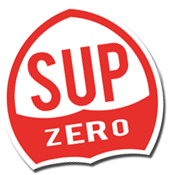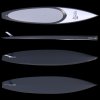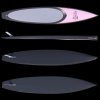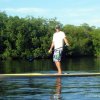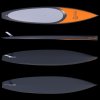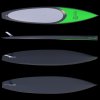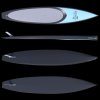[please login to make this ad block disappear]
My favorite gear: 
Login first to add this to your Likes or Haves.

Login first to add this to your Likes or Haves.
Elite 12'6"
Compare
Write Review
Short Facts
Brand
King's

1703 La Costa Meadows Drive
San Marcos
CA 92078
USA
Phone: +1 760.944.6197
· Show brand details.
· Show all King's products.

1703 La Costa Meadows Drive
San Marcos
CA 92078
USA
Phone: +1 760.944.6197
· Show brand details.
· Show all King's products.
Model Year
Usage
Intended Paddling Environment
Construction & Material
Recommended Retail Price
USD 2,490
Available Colors
Available In White, Light Blue, Medium Blue, Red, Orange, Sea foam Green, Lime Green, Yellow, Pink, Green and Carbon Fiber
Stats (Metric)
Length
381 cms / 12'6"
Minimum Paddler Weight
8.2 kg / 18 lbs
Maximum Paddler Weight
9.1 kg / 20 lbs
The King’s Elite 12’ 6” race board is a fine example a proven race winner. Unlike many race boards the King’s Elite racer is super stable yet incredibly fast. This stability allows you to focus on your paddling without sacrificing speed. The stability and speed of this board exceeds that of nearly all other SUP boards—making it the perfect board for all skill levels. We build race boards for those who are absolutely serious about their equipment and winning races. - Why are King’s Boards so much better?
There is no board in the world as fast, strong and light as a King’s race board. King’s race boards have a very slight vee running the entire length of the board--the bow is designed to very gently displace water without causing a wake--the cockpit is sunken so your feet are as close as possible to the surface of the water--the bottom side of the tail has a slight roll allowing the water to gently release off the end of the board. King's boards are engineered to perform. They represent a product where hydrostatic theory, art, craftsmanship, aesthetics and testing all come together to create one of the most highly coveted race boards in the world. King's race boards track straight, are highly stable, are easy to paddle, have unequaled glide, are super fast and have a long list of race wins!
Adding to the great design, King’s race boards are constructed using our exclusive carbon fiber vacuum bagging techniques. Vacuum bagging is a technique employed to create mechanical pressure on a laminate during its cure cycle. Pressurizing a composite lamination serves several functions. First, it removes trapped air between layers. Second, vacuum bagging compacts the fiber layers for efficient force transmission among fiber bundles and prevents shifting of fiber orientation during cure. Third, it reduces humidity. Finally, and most important, the vacuum bagging technique optimizes the fiber-to-resin ratio in the composite part. These advantages have for years enabled aerospace and racing industries to maximize the physical properties of advanced composite materials such as Graphite (carbon fiber,) aramid, and epoxy.
• What is Fiber-To-Resin Maximization and Why Is It Important?
The reason that composites are used increasingly is the strength-to-weight advantages that they offer. The key to obtaining these advantages is maximizing the fiber-to-resin ratio. The reinforcement (fiberglass, aramid Kevlar® graphite, etc. is not particularly strong in the textile state. As well, thermosetting resins such as polyester and epoxy are quite brittle if cured without reinforcement. If excess resin exists in the laminate, the laminate will have more of the properties of resin only. If too little resin exists, places where the reinforcement is dry will cause weak spots. To optimize the resin content, the entire reinforcement must be saturated with resin with as little excess as possible. The technique of “squeezing out” excess resin to obtain a maximized fiber-to-resin content is the theory of vacuum bagging.
• How Much Resin Is Optimum?
Typically, a hand laminate uses in excess of 100% fabric weight by resin. A refined aerospace or racing composite lamination will obtain as little as 40% resins to fabric ratio. Determining the perfect combination for a given lamination is a sophisticated engineering problem but a good target is 60% resin to fabric weight ratio. It is important to recognize that dry spots are “weaker” than resin-rich areas and maximization of fiber-to-resin is relative to a “real-life” fabricator and his or her ability to improve the boards being made. Over the years King’s processes have evolved to a point where our resin to fabric ratios run between 40% to 50%.
Finally, King’s has set the standard by which performance, weight and durability are judged. We take great pride in what we do and sincerely appreciate your taking the time to read and understand the difference between King’s boards and all other brands. In the end, the light weight, strength, stability and speed make the difference. Our race boards are favorites for those of you who are absolutely serious about your equipment and winning races.
• Warranty Information :
King's Paddle Sports produces stand up paddle boards that are strong and durable. Buyer acknowledges and is fully responsible for the care and protection of the boards. This includes keeping the boards out of direct sunlight when the board is not in use. Buyer also acknowledges the fact the even limited exposure to direct sunlight and or heat above 100 degree F will damage the board.
There is no board in the world as fast, strong and light as a King’s race board. King’s race boards have a very slight vee running the entire length of the board--the bow is designed to very gently displace water without causing a wake--the cockpit is sunken so your feet are as close as possible to the surface of the water--the bottom side of the tail has a slight roll allowing the water to gently release off the end of the board. King's boards are engineered to perform. They represent a product where hydrostatic theory, art, craftsmanship, aesthetics and testing all come together to create one of the most highly coveted race boards in the world. King's race boards track straight, are highly stable, are easy to paddle, have unequaled glide, are super fast and have a long list of race wins!
Adding to the great design, King’s race boards are constructed using our exclusive carbon fiber vacuum bagging techniques. Vacuum bagging is a technique employed to create mechanical pressure on a laminate during its cure cycle. Pressurizing a composite lamination serves several functions. First, it removes trapped air between layers. Second, vacuum bagging compacts the fiber layers for efficient force transmission among fiber bundles and prevents shifting of fiber orientation during cure. Third, it reduces humidity. Finally, and most important, the vacuum bagging technique optimizes the fiber-to-resin ratio in the composite part. These advantages have for years enabled aerospace and racing industries to maximize the physical properties of advanced composite materials such as Graphite (carbon fiber,) aramid, and epoxy.
• What is Fiber-To-Resin Maximization and Why Is It Important?
The reason that composites are used increasingly is the strength-to-weight advantages that they offer. The key to obtaining these advantages is maximizing the fiber-to-resin ratio. The reinforcement (fiberglass, aramid Kevlar® graphite, etc. is not particularly strong in the textile state. As well, thermosetting resins such as polyester and epoxy are quite brittle if cured without reinforcement. If excess resin exists in the laminate, the laminate will have more of the properties of resin only. If too little resin exists, places where the reinforcement is dry will cause weak spots. To optimize the resin content, the entire reinforcement must be saturated with resin with as little excess as possible. The technique of “squeezing out” excess resin to obtain a maximized fiber-to-resin content is the theory of vacuum bagging.
• How Much Resin Is Optimum?
Typically, a hand laminate uses in excess of 100% fabric weight by resin. A refined aerospace or racing composite lamination will obtain as little as 40% resins to fabric ratio. Determining the perfect combination for a given lamination is a sophisticated engineering problem but a good target is 60% resin to fabric weight ratio. It is important to recognize that dry spots are “weaker” than resin-rich areas and maximization of fiber-to-resin is relative to a “real-life” fabricator and his or her ability to improve the boards being made. Over the years King’s processes have evolved to a point where our resin to fabric ratios run between 40% to 50%.
Finally, King’s has set the standard by which performance, weight and durability are judged. We take great pride in what we do and sincerely appreciate your taking the time to read and understand the difference between King’s boards and all other brands. In the end, the light weight, strength, stability and speed make the difference. Our race boards are favorites for those of you who are absolutely serious about your equipment and winning races.
• Warranty Information :
King's Paddle Sports produces stand up paddle boards that are strong and durable. Buyer acknowledges and is fully responsible for the care and protection of the boards. This includes keeping the boards out of direct sunlight when the board is not in use. Buyer also acknowledges the fact the even limited exposure to direct sunlight and or heat above 100 degree F will damage the board.
User reviews
There are no user reviews for this listing.
Already have an account? Log in now or Create an account
